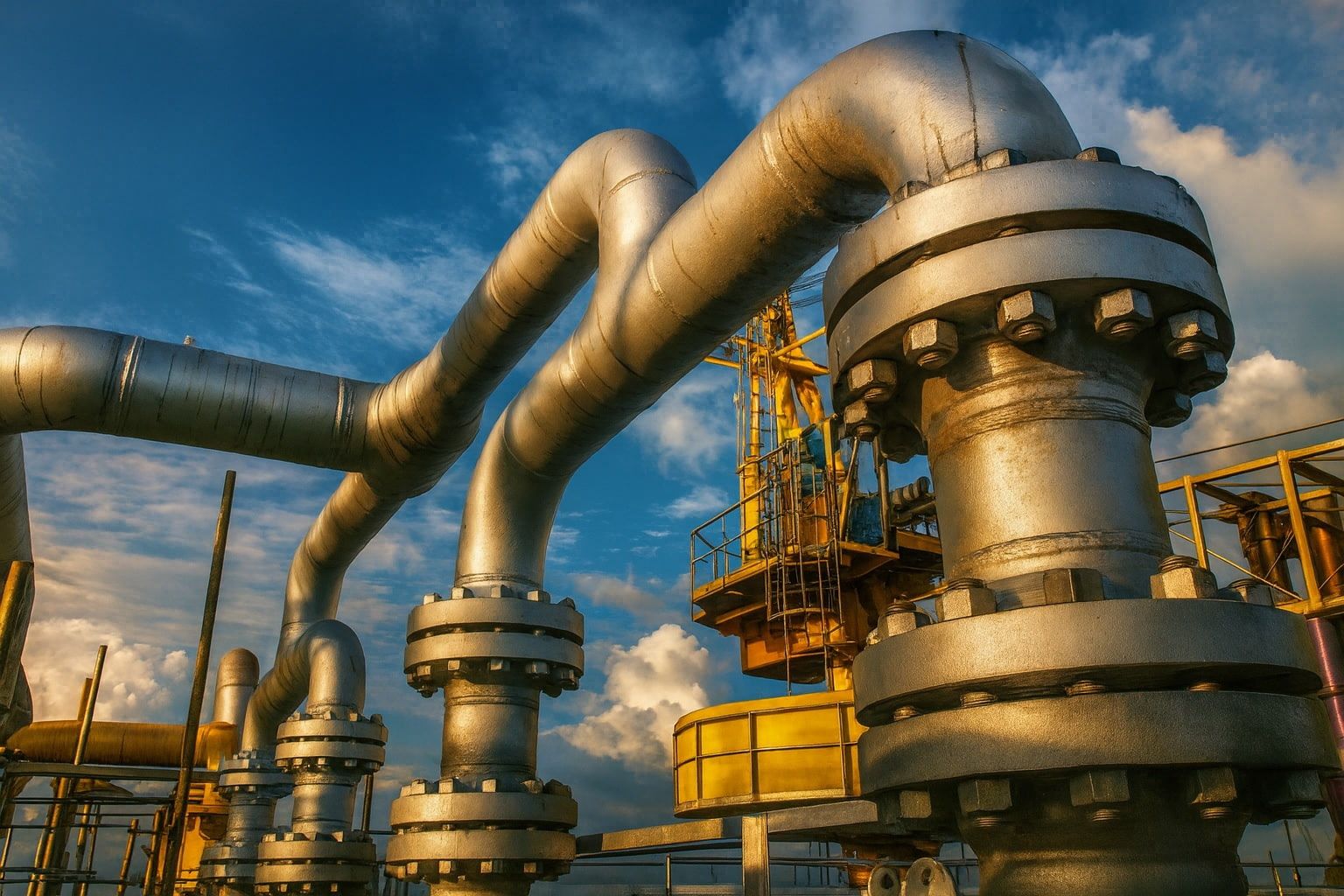- Emergency Price Freeze: Kazakhstan’s government has frozen gasoline and diesel prices, as well as utility tariffs, nationwide from October 16, 2025 until at least spring 2026 [1]. Economy Minister Serik Jumangarin confirmed the fuel price moratorium will remain “until at least next spring” as authorities battle surging inflation [2].
- Inflation at Two-Year High: Annual inflation hit 12.9% in September 2025, the highest in two years, far above the central bank’s 5-6% target [3]. In response, the National Bank of Kazakhstan hiked its key interest rate to a record 18% in early October [4], attempting to cool price growth.
- War Fallout Driving Prices: Officials blame rising fuel prices in Russia – Kazakhstan’s main trading partner – amid the Ukraine war for the domestic fuel crunch [5]. “The situation… is related to the conflict between Russia and Ukraine, and petroleum product prices in the neighbouring country are rising sharply,” Minister Jumangarin noted [6]. A recent Ukrainian drone strike on a Russian gas plant even forced cuts at a Kazakh oilfield, underscoring the region’s interlinked energy markets [7].
- Averting Social Unrest: Fuel costs are a sensitive issue in Kazakhstan. Hundreds were killed in mass protests after a sudden spike in fuel prices in January 2022 [8]. Authorities hope the current price freeze will prevent a repeat of such unrest [9] by easing the pressure on households and transport costs.
- Temporary Relief, Experts Warn: Economists say the freeze should slow inflation in the short term – since fuel affects the cost of almost all goods – and help preserve consumers’ purchasing power [10]. It also serves to “ease… accumulating social tensions” amid public frustration with new taxes and reforms [11]. However, experts caution this is only a temporary fix through Q1 2026, and underlying problems will need addressing once the moratorium lifts [12] [13].
Kazakhstan Freezes Fuel & Utility Prices to Tame Inflation
Facing the fastest inflation in years, Kazakhstan’s government has taken the dramatic step of freezing prices on fuels and household utilities. The nationwide moratorium took effect on October 16, 2025, halting any further price increases for AI-92 gasoline and diesel fuel until inflation stabilizes, and similarly suspending hikes in tariffs for water, electricity, heating and natural gas for all consumers until at least end-March 2026 [14] [15]. These emergency controls aim to “stabilize the economy and protect citizens’ interests” amid the inflation surge, following direct instructions from President Kassym-Jomart Tokayev [16]. The freeze on energy prices is part of a broader relief package – including doubling food price subsidies and other support – intended to “ensure macroeconomic stability” during a period of economic strain [17] [18].
Economy Minister Serik Jumangarin announced that the fuel price cap will last “until at least next spring” (spring 2026) [19]. “What’s important for us now is to wait, at least until next spring. We need to wait for the situation in neighbouring countries to stabilize,” Jumangarin told reporters in Astana [20]. He attributed Kazakhstan’s fuel price spike largely to external factors – notably knock-on effects from Russia’s domestic fuel market turmoil due to the war in Ukraine [21]. Russia is Kazakhstan’s biggest neighbor and trading partner, so its supply disruptions quickly spill across the border. “The situation is actually related to the events unfolding due to the conflict between Russia and Ukraine, and petroleum product prices in the neighbouring country are rising sharply,” Jumangarin explained [22]. In other words, soaring fuel costs in Russia (exacerbated by wartime logistics and sanctions) have pressured Kazakhstan’s market, prompting Astana to intervene.
Alongside the price freeze, officials are scrambling to ensure fuel supply isn’t disrupted by the controls. Prime Minister Alikhan Smailov ordered the Energy Ministry and regional authorities to enforce the moratorium strictly while guaranteeing an uninterrupted fuel supply to the domestic market [23]. This suggests the government may deploy subsidies or restrict exports if needed so that local stations don’t run dry under the price cap. Authorities also vowed to prevent spikes in other essentials – pledging financial support for farmers and food producers to keep staples affordable [24]. In addition, recognizing that high interest rates have made borrowing costly, the government will double the volume of subsidized mortgage loans (to 500 billion tenge, or ~$926 million) to maintain housing affordability despite a shortage of commercial lending [25] [26]. These measures reflect a multi-front effort to cushion households from the cost of living crunch without derailing longer-term economic reforms.
Inflation Soars to 12.9%, Central Bank Hikes Rates
Kazakhstan’s inflation problem has been building for months. In September 2025, annual inflation officially jumped to 12.9%, its highest level since late 2023 [27]. Prices for food, fuel, and services have been climbing in double digits, eroding purchasing power. This inflation rate far exceeds the National Bank of Kazakhstan (NBK)’s target range of 5–6%, and is on track to reach around 14% by year-end according to some forecasts [28]. In response, the NBK moved aggressively: earlier in October it raised the benchmark interest rate to 18%, an unprecedented high for Kazakhstan [29]. By tightening monetary policy, the central bank aims to cool demand and credit growth, albeit at the cost of slower economic activity.
NBK Governor Timur Suleimenov has frankly pointed to internal factors behind the inflation surge. He argues that “there is too much money in the economy”, with monetary aggregates up ~18%, fueling excess demand [30]. On Oct. 22, Suleimenov told lawmakers that massive fiscal spending and a boom in consumer lending have created “excessive liquidity” in the economy [31] [32]. In simple terms, government stimulus and easy credit are pumping money into people’s pockets faster than the economy’s ability to supply goods, leading to an overheating economy and price spikes [33] [34]. “Inflation in our country is largely caused by the fact that there is too much money in the economy… a lot of liquidity is being injected,” the central bank chief explained [35]. He noted that domestic production can’t meet the booming consumer demand, so excess spending spills into imports, which in turn pressures the tenge currency and adds imported inflation [36].
To regain control, Suleimenov is urging fiscal belt-tightening and credit restraints. “Fiscal consolidation through the new Tax and Budget Codes and stricter credit controls will help limit excess money in circulation,” he said, stressing that the NBK plans to rein in money supply growth in coming months [37]. Essentially, the central bank wants the government to rein in budget spending and for banks to curb unchecked lending, attacking inflation at its monetary roots. However, these deflationary moves are painful – high interest rates have sharply slowed mortgage lending and business credit, prompting the government’s aforementioned steps to support borrowers. The balancing act between stabilizing prices and sustaining growth is very delicate. Minister Jumangarin has even cautioned that overdoing anti-inflation measures could undercut Kazakhstan’s strong economic expansion (5%+ GDP growth) [38]. With GDP rising briskly outside the oil sector and billions in investment flowing in [39] [40], officials are wary of choking off the recovery. This explains why the government has paired the central bank’s tough medicine with its own mix of price controls and targeted subsidies, hoping to curb inflation without sparking a recession.
War Impacts and Regional Price Pressures
Kazakhstan’s inflation fight cannot be separated from the broader regional turmoil caused by Russia’s war in Ukraine. Despite being an oil and gas exporting nation (Kazakhstan pumps roughly 2% of the world’s oil supply [41]), Kazakhstan depends on Russia for much of its fuel processing and imports. In fact, a significant share of northwestern Kazakhstan’s natural gas is processed over the border at Russia’s Orenburg plant. So when that facility was partially knocked offline by a Ukrainian drone strike in October, Kazakhstan felt the shock. The attack on Orenburg temporarily cut output at Kazakhstan’s giant Karachaganak oil and gas field – reducing its production by hundreds of thousands of barrels of oil equivalent per day [42] [43] – until operations resumed. The incident highlighted Kazakhstan’s vulnerability: its energy infrastructure is intertwined with Russia’s, meaning conflict-related disruptions can directly hit Kazakh supplies [44] [45]. (Astana’s government did clarify that gas supply to local consumers remained uninterrupted thanks to reserve mechanisms [46], but the scare was enough to raise concern.)
More routinely, Russia’s domestic fuel market upheaval has spilled into Central Asia. In recent months, Russia saw shortages and price spikes in gasoline and diesel, driven by wartime export curbs and logistics issues. As Russian fuel prices jumped, some fuel flowed out of Kazakhstan (legally or via gray routes) to capitalize on higher prices, which threatened local availability. Rather than allow domestic prices to soar to Russian levels, Kazakhstan chose to lock in prices via the freeze and manage the supply gap with administrative measures [47]. The government’s hope is that by spring 2026, the situation in Russia – and by extension regional fuel markets – will stabilize [48], making it safer to lift the caps. “We need to wait for the situation in neighbouring countries to stabilize,” Jumangarin emphasized [49], indicating that Kazakhstan sees this as a temporary buffer during an extraordinary period of external stress.
Notably, these price interventions come at a time when global oil prices have actually been moderating. Brent crude has been trading around the mid-$60s per barrel in recent days (even “flirting with $60” at one point) [50], amid concerns of oversupply in world markets. So Kazakhstan’s inflation is less about a general global oil shock and more about regional dislocations and internal factors. As analyst Zhulduz Baizakova observes, “Russia’s fuel shortages created a domino effect in Central Asia’s markets”, leaving countries like Kazakhstan scrambling to shield consumers (as reported by Asia-Plus) [51]. Additionally, Kazakhstan’s own policies earlier this year – such as raising fuel taxes or export duties – may have contributed to price pressures and cross-border smuggling, though the freeze now supersedes those measures. In essence, the war next door has forced Kazakhstan to prioritize security of supply and social stability over free-market pricing, at least for the next several months.
Geopolitically, Kazakhstan is performing a careful balancing act. It maintains close ties with Moscow (it is part of the Eurasian Economic Union with Russia) yet has not endorsed the war in Ukraine. Astana has tried to avoid antagonizing the Kremlin while also quietly helping mitigate Russia’s sanctions evasion. The government’s “diplomatic tightrope” on the war [52] means it cannot publicly blame Russia for its woes – but the fuel freeze speaks louder than words, showing Kazakhstan is unwilling to let Russia’s domestic troubles destabilize its own economy. As winter approaches, keeping a lid on fuel and heating costs is also crucial to prevent any backlash that could strain this diplomatic tightrope.
Flashbacks to 2022 Unrest Shape Policy
Kazakhstan’s leadership is acutely aware that energy prices can spark political turmoil. In January 2022, the government learned this the hard way: a sudden doubling of liquefied petroleum gas (LPG) prices (after lifting price caps) ignited the worst civil unrest in Kazakhstan’s modern history [53]. What began as localized protests over fuel costs in the western Mangistau region spread nationwide, tapping into deeper grievances. The demonstrations turned violent and were met with a harsh crackdown – resulting in over 200 deaths, a state of emergency, and even Russian-led troops being called in to restore order [54]. That trauma still looms large. It toppled the previous cabinet and spurred President Tokayev to promise economic reforms to address public discontent.
With that memory fresh, the current government is keen to avoid any repeat of a “fuel price Maidan.” It’s no coincidence that President Tokayev himself ordered officials to “mitigate the social impact” of economic changes [55]. The ongoing rollout of a new tax code and other reforms had already stirred anxieties, especially among small businesses, by late 2025 [56]. “Over the past six months, society has been overwhelmed by the new reforms being discussed… specifically the tax ones,” notes oil and gas expert Askar Ismailov [57]. According to Ismailov, further fuel price hikes now would have “only increase[d] public irritation and protest sentiments” on top of that reform fatigue [58]. Thus, slapping a moratorium on fuel and utility costs serves as a pressure valve to ease social tensions, giving people a breather from rising living costs.
Kazakhstan’s approach can be seen as a form of pre-emptive crisis management. By intervening decisively before discontent boils over, the government seeks to maintain stability through a difficult winter. “The recent decisions served to ease these accumulating social tensions, even though this relief is temporary,” Ismailov observes of the price freeze and related measures [59]. Officials have implicitly acknowledged a misstep in how some economic changes were rolled out; indeed, the government partially rolled back or delayed certain new SME-related policies as an “error correction,” the expert notes [60]. The price controls on fuel can similarly be viewed as an emergency correction to prevent popular anger from erupting. As one Asia-Plus analysis put it, “the announcement comes amid public sensitivity to price surges,” and the authorities “hope the current interventions will prevent similar unrest and maintain stability” [61].
Of course, freezing prices by decree is not a sustainable long-term strategy. Such measures can backfire if shortages develop or if the fiscal cost of subsidies soars. But in the government’s eyes, the immediate risk of social upheaval outweighs those medium-term risks. Memory of the 2022 chaos gives the state a strong incentive to prioritize short-term calm – essentially buying time to implement deeper fixes in a more controlled way.
Expert Views: Short-Term Fix, Long-Term Questions
Most economists agree that Kazakhstan’s price freeze will provide short-term relief, but warn it is no cure-all for inflation. “This measure will slow price increases since nearly all goods rely on transportation costs,” explains Askar Ismailov, meaning cheaper fuel should translate into slower rises for food and other products [62]. By extension, “inflation will… slow, helping partially support the purchasing power of most Kazakhstanis given current income levels,” Ismailov adds [63]. In a country where wages haven’t kept up with prices [64], even a temporary breather from inflation is welcome news for consumers.
Crucially, observers underscore the social impact of the freeze. As noted, Ismailov and others believe halting price hikes will “ease… protest sentiments” among a weary public [65]. The government itself cited “mitigating the negative effects of ongoing economic reforms” as a key goal of these measures [66]. By capping fuel and utility bills, authorities effectively signal that they hear the public’s frustrations and are willing to intervene on their behalf. This could shore up trust in the short term, buying goodwill as tougher structural reforms (on taxes, subsidies, etc.) continue to roll out. “These measures prevented further deterioration of the situation,” Ismailov notes, though he calls them a form of “temporary relief… effective only until the end of the first quarter of 2026.” After that, “the subsequent impact on the economy will be determined by the steps taken” once the moratorium expires [67].
And that is the million-tenge question: what happens when the freeze is lifted in spring 2026? If underlying inflationary pressures remain, Kazakhstan could face a “catch-up” surge in prices once controls are removed – essentially delayed pain. The expert Ismailov cautions that authorities will likely need to reconsider their approaches or even personnel behind some recent reforms, implying deeper policy changes might be needed to truly tame inflation [68]. He hints that certain decisions “were not suitable for Kazakhstan at this time” and ended up raising costs or taxes in ways that risk “weakening the national economy” [69]. This suggests that beyond the headline freeze, the government may need to revise some of its new tax or economic policies that have contributed to price pressures or business costs.
Independent analysts also emphasize structural solutions. Many argue that Kazakhstan must address its heavy reliance on imports and narrow industrial base to escape the cycle of high inflation [70] [71]. Only boosting domestic manufacturing and agriculture can provide a lasting solution to inflation, some economists contend [72] [73]. By producing more at home – from food to fuel – Kazakhstan could reduce its vulnerability to external price shocks and currency fluctuations. “Kazakhstan needs real production… [that] reduces reliance on imports, supports the tenge, and addresses budget deficits,” writes political analyst Gaziz Abishev, arguing for large-scale industrialization as the true cure for inflation [74] [75]. In that light, the current price freeze is merely treating the symptoms of inflation, while the “disease” of an import-dependent economy remains. The National Bank’s focus on excess liquidity addresses one side of the equation (demand), but the supply side – diversifying and strengthening local production – is the other key piece to sustainably tame price growth.
Outlook: Balancing Act into 2026
As Kazakhstan navigates the coming months, it faces a delicate balancing act between short-term relief and long-term reform. The fuel and utility price freeze, by design, buys time until spring 2026. By then, authorities hope inflation will have moderated (helped by the central bank’s tight policy and a bit of luck on external factors like global commodity prices and the Russia-Ukraine conflict). If inflation falls and public anger cools, the government may attempt a gradual lifting of price controls to return to market-based pricing. However, that transition will need to be carefully managed to avoid a sudden jump in prices. One likely approach is a phased or partial lifting, possibly keeping some subsidies in place for vulnerable groups or critical goods while allowing other prices to adjust.
Financially, Kazakhstan can afford some intervention in the short run – it earns substantial revenue from oil exports, and energy prices internationally are not sky-high at the moment. But extended price freezes can strain budgets or deter investment if companies fear losses. The state will likely compensate fuel retailers or state-owned suppliers for lost revenue during the cap to ensure continued supply. Much will depend on whether the external triggers normalize: if Russia’s fuel market stabilizes and war-related disruptions ease by spring, Kazakhstan can more confidently remove the freeze. On the other hand, if regional turmoil persists or inflation stays sticky above 10%, officials may face a tough choice: extend the controls further (into mid-2026), or risk public ire by unleashing pent-up price increases. Economy Minister Jumangarin hinted the freeze could be prolonged if needed, saying they’ll “wait for the situation… to stabilize” before acting [76].
Meanwhile, the government is pushing ahead on other economic fronts. Notably, Kazakhstan is striving to attract foreign investment and integrate into global markets, perhaps to cushion the economy. In mid-October, a Kazakh delegation even visited the New York Stock Exchange to explore listing government bonds and state-run companies abroad [77]. NYSE officials discussed how Kazakh sovereign bonds or major firms could be floated internationally, underscoring Kazakhstan’s ambition to tap global capital [78]. Such moves indicate that despite short-term price interventions at home, the country’s leadership is keen to project an image of long-term financial modernization and openness. Maintaining economic stability through the election cycles and geopolitical uncertainty is crucial for these plans. As one financial analyst quipped, “You can’t list on the NYSE if your home streets are on fire.” Stability, therefore, is paramount.
In summary, Kazakhstan’s freeze of fuel and utility prices is a bold gambit born of urgency. It reflects a government determined to get a grip on inflation and avoid stirring public unrest, even if it means heavy-handed market intervention. For now, the policy will likely bring a measure of relief – inflation may tick down in coming months as transport costs stabilize and consumers catch their breath. The true test comes in 2026: can Kazakhstan deftly unwind these controls without reigniting price spikes or protests? Much will hinge on broader reforms to tackle the roots of inflation – from curbing excess money growth to boosting domestic production – in the interim. Observers are watching closely. As President Tokayev put it, high inflation is “eating away” at livelihoods [79], and taming it is essential for Kazakhstan’s promise of prosperity. The fuel price freeze is a stop-gap measure on the road to that goal, one that buys precious time at a critical juncture. Whether that time is used wisely to enact lasting fixes will determine if Kazakhstan can emerge in spring 2026 with a stronger, more stable economy – or if it will face the same old specter of inflation once the controls are lifted.
Sources: Kazakhstan government announcements and news agencies [80] [81]; Reuters [82] [83]; OilPrice [84] [85]; The Astana Times [86] [87]; Kazinform (Kazakhstan National News) [88] [89]; Asia-Plus Tajikistan [90]; Times of Central Asia [91] [92].
References
1. asiaplustj.info, 2. www.reuters.com, 3. www.reuters.com, 4. www.reuters.com, 5. www.reuters.com, 6. www.reuters.com, 7. www.reuters.com, 8. www.reuters.com, 9. asiaplustj.info, 10. qazinform.com, 11. qazinform.com, 12. qazinform.com, 13. qazinform.com, 14. astanatimes.com, 15. asiaplustj.info, 16. astanatimes.com, 17. astanatimes.com, 18. asiaplustj.info, 19. www.reuters.com, 20. www.reuters.com, 21. www.reuters.com, 22. www.reuters.com, 23. asiaplustj.info, 24. asiaplustj.info, 25. astanatimes.com, 26. asiaplustj.info, 27. www.reuters.com, 28. timesca.com, 29. www.reuters.com, 30. astanatimes.com, 31. astanatimes.com, 32. astanatimes.com, 33. astanatimes.com, 34. astanatimes.com, 35. astanatimes.com, 36. astanatimes.com, 37. astanatimes.com, 38. timesca.com, 39. timesca.com, 40. timesca.com, 41. www.reuters.com, 42. oilprice.com, 43. oilprice.com, 44. oilprice.com, 45. oilprice.com, 46. oilprice.com, 47. www.reuters.com, 48. www.reuters.com, 49. www.reuters.com, 50. oilprice.com, 51. asiaplustj.info, 52. www.reuters.com, 53. www.reuters.com, 54. www.reuters.com, 55. astanatimes.com, 56. qazinform.com, 57. qazinform.com, 58. qazinform.com, 59. qazinform.com, 60. qazinform.com, 61. asiaplustj.info, 62. qazinform.com, 63. qazinform.com, 64. timesca.com, 65. qazinform.com, 66. asiaplustj.info, 67. qazinform.com, 68. qazinform.com, 69. qazinform.com, 70. timesca.com, 71. timesca.com, 72. timesca.com, 73. timesca.com, 74. timesca.com, 75. timesca.com, 76. www.reuters.com, 77. ts2.tech, 78. ts2.tech, 79. timesca.com, 80. astanatimes.com, 81. asiaplustj.info, 82. www.reuters.com, 83. www.reuters.com, 84. oilprice.com, 85. oilprice.com, 86. astanatimes.com, 87. astanatimes.com, 88. qazinform.com, 89. qazinform.com, 90. asiaplustj.info, 91. timesca.com, 92. timesca.com










